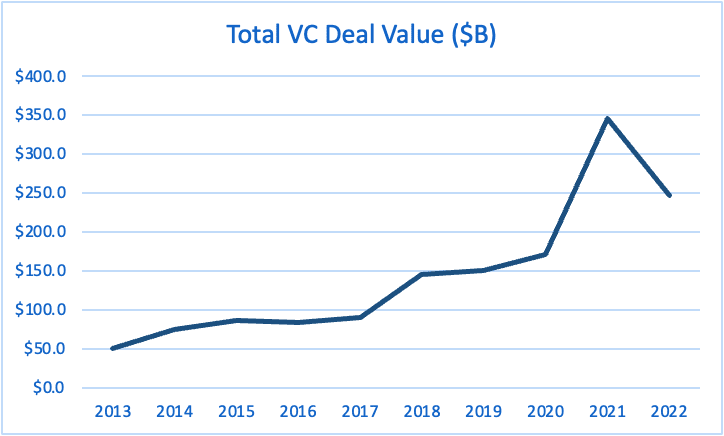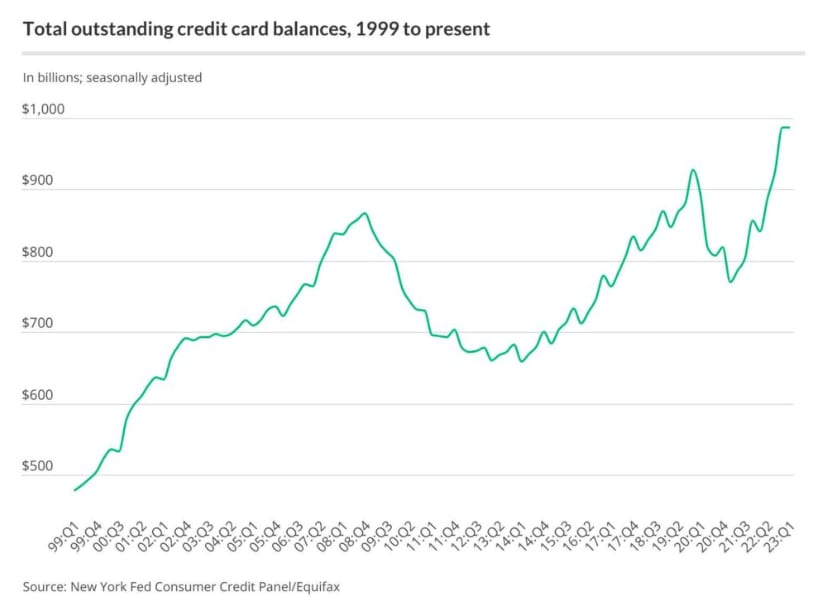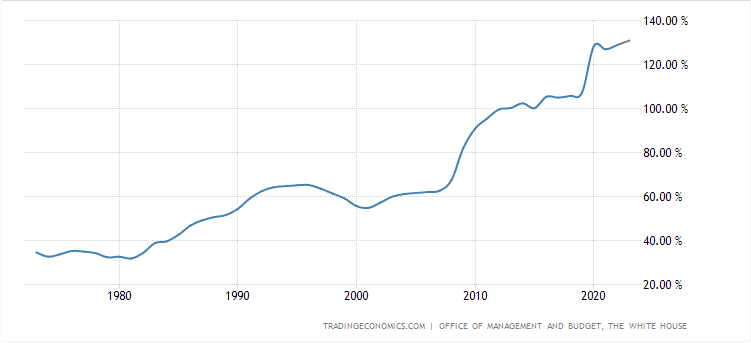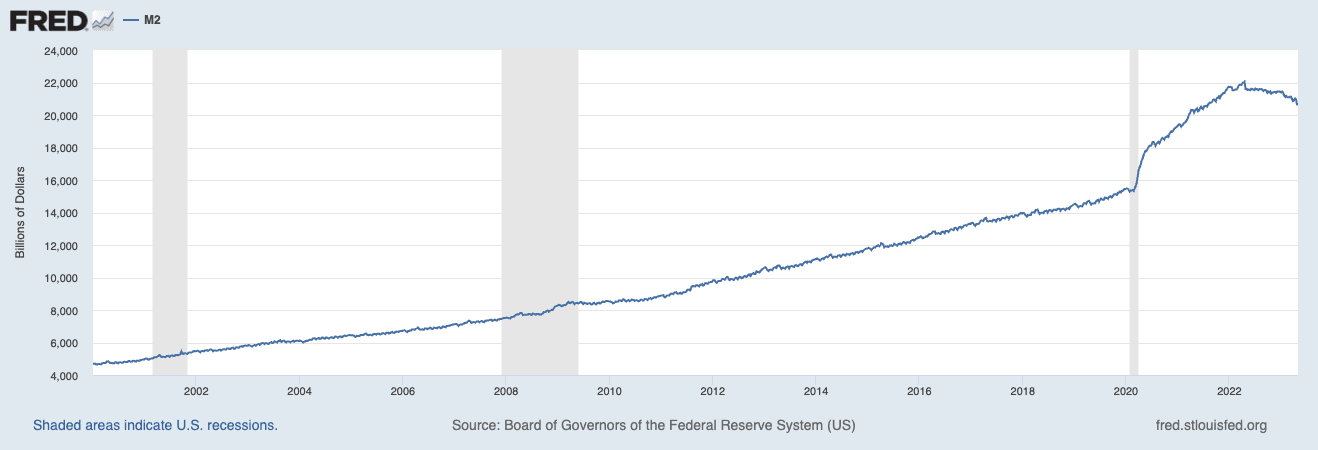The Venture Capital Bubble and Its Impact on Employment
The venture capital (VC) market, much like other financial markets, is not immune to the cyclical nature of booms and busts. In 2021, we witnessed a remarkable, fully-inflated VC bubble. The annual capital invested in startups had been on a steady upward trajectory, moving from $50 billion in 2013 and reaching a pinnacle of $349 billion in 2021. And as with all economic bubbles, it was bound to burst.
While precise data isn't readily available, based on the historical interplay between VC funding and startup employment, it's plausible that this wave of capital led to a surge in employment within VC-backed startups. Considering that startups typically allocate nearly all raised capital towards salaries, the influx of VC investments would have significantly reshaped the employment landscape. While overly simplistic, a direct correlation analysis suggests that employment in VC-backed startups might have escalated from a historical baseline of 2-3% of full-time wage and salary earners to a peak of 6-7% today.
The VC market started its course correction in 2022. However, due to the financial runway that fundraising provides startups, typically around 18 to 24 months, the full impact of this correction on the labor market will likely manifest with a delay, with the most significant effects not expected until late 2023 and into 2024.
This projection aligns with anecdotal evidence from discussions with several large venture firms. They each express concerns that their portfolio companies have been slow in adjusting their workforce sizes to match the new economic reality. If these observations are correct, we should anticipate the onset of large-scale layoffs in the startup sector to begin manifesting in the latter half of this year as those startups that raised capital in 2021 exhaust their runway.
And let's not forget that these aren't just any jobs. The average startup employee earns around $95,000 a year, roughly 70% higher than the median wage in the US.
If my analysis holds, and startup employment has indeed surged from an estimated 3.8 million employees in 2020 to around 7.7 million today, we could be facing a significant contraction in the very near future. Should the employment level revert to the 2019 numbers by the end of 2024 (as the capital raised during the VC bubble is exhausted), we might see millions of high-income earners facing layoffs over the next year and a half.
The Ripple Effect of Startup Layoffs
The economic consequences of these projected layoffs would reverberate far beyond the immediate effect on those employees. Multiple macroeconomic factors could intensify these repercussions, setting off a chain reaction of substantial challenges for the wider U.S. economy.
Historically, these high-skill employees have been in strong demand, with most finding new employment swiftly after layoffs. However, this time the landscape is different. Our economy currently teeters on a precarious edge, characterized by near-zero projected growth in real GDP for 2023 (according to the CBO), symptomatic of an economy flirting with stagnation. Coupled with declining U.S. productivity rates over the past few years, firms may be expected to rein in their hiring activities. This is particularly true for the high-skilled, high-wage positions common to the startup sector, a trend already evident among large tech companies.
Complicating matters further are recent advancements in AI and their unknown impact on the demand for skilled labor, particularly roles typically found in startups such as software developers, administrative staff, and sales & marketing personnel. It's unclear what the long-term employment impact will be, but signs indicate that major employers are beginning to reassess their future hiring needs in light of these developments. IBM's recent announcement of a hiring freeze for back-office roles, for example, is a direct response to their expectation that AI will replace around 3% of their total workforce over the next few years.
So, let's consider the broader impact on the U.S. economy if we do indeed see:
- The loss of millions of high-paying jobs from the tech sector over the next 18 months, and
- Those affected struggle in finding new employment swiftly.
The ripple effects could potentially be immense. High earners like those employed in startups often have larger disposable incomes. If their earnings drop or cease altogether due to unemployment, it could trigger a substantial decline in consumer spending.
This high-wage demographic also influences housing market dynamics due to their propensity to own homes or afford higher rents. A surge in unemployment among this group could destabilize the housing market. Struggling to maintain their lifestyles, many might be compelled to sell their homes, flooding the market with additional supply. An increasing supply coupled with already dampened demand due to higher interest rates could precipitate a sharp drop in housing prices, and potentially trigger a housing market crisis.
With their above-average earnings, startup employees are also more likely to hold significant consumer credit, such as credit cards, car loans, and mortgages. As one might expect, US credit card debt has soared since Q4 of 2020. Rising unemployment could lead to an increase in defaults on these obligations.
Building on these concerns, layoffs in the startup sector could add stress to the already vulnerable financial sector. Bank balance sheet anxieties coupled with strain from potential commercial real estate defaults due to record high office vacancies already has the financial sector worried. The last thing the sector needs is an unexpected surge in consumer credit defaults.
The cumulative effects of these issues could trigger a significant contraction in the economy. As unemployment escalates and consumer spending plummets, businesses may curtail investments due to lower demand and tighter credit conditions. This has the potential to set off a downward spiral, exacerbating the economic downturn and making recovery an even more formidable challenge.
The U.S. Government May Struggle to Respond
The U.S. government usually has a safety net at the ready when it comes to financial crises. With tried-and-true tools like lowering interest rates and issuing stimulus packages, it has weathered many an economic storm. But looking at today's fiscal climate, you have to ask: "What happens when the safety net has holes?"
The U.S. federal debt is skyrocketing past $32 trillion, with a debt-to-GDP ratio of over 130% projected for this year. The current year's deficit spending is predicted to hit $1.5 trillion. Couple all of this with rising interest rates on U.S. debt and further speculations that those interest rates could reach nearly 6%, and you can start to see why there's reason for concern should a sudden economic crisis unfold.
In any ordinary crisis, the go-to move for the government would be to kickstart the economy with deficit spending and lower interest rates. However, when you've already maxed out your credit card, spending your way out of trouble isn't necessarily the best option. And with the recent interest rate hikes to combat inflation, a sudden rate reversal could be difficult to pull off.
So, let's assume the worst does happen over the next 18 months: mass layoffs ensue, the economy stumbles, and the government needs to intervene. What's the playbook look like?
Monetary Policy: Here, the Federal Reserve would find itself between a rock and a hard place. Over the past year and a half, they've been bumping up interest rates to keep inflation in check. In response to an economic downturn, the standard procedure would be to drop interest rates to boost activity. But with inflation still snapping at our heels, cutting rates might just stoke the flames, leading us into the murky waters of stagflation - a stagnant economy with stubbornly high inflation. So, the Fed finds itself in a predicament – either they risk fanning inflation or exacerbating the downturn.
Fiscal Policy: On the fiscal side, things aren't any rosier. Normally, the government would roll out the big guns with a surge in stimulus spending to soften the economic blow. But the fiscal health of the nation is already in question with record-high national debt, significant deficit spending, and rising interest rates on U.S. debt. In addition, there are concerns of decreasing demand for U.S. treasuries, which if realized, could push interest rates even higher, thereby escalating debt service costs. This confluence of factors makes large-scale stimulus spending a risky proposition that could potentially plunge us into a deeper debt crisis.
The interplay between reduced consumer spending, interest rate adjustments, and potential quantitative easing policies presents a complex dance with inflation. Though decreased spending might ease inflation by reducing demand, if the Fed simultaneously slashes interest rates and pumps money into the economy, they could be fanning the inflationary flames, especially given that the money supply is already so high.
Whether my prediction of a looming employment bubble is proven out or not, the concerns over our ability to effectively respond to any economic downturn over the coming years (whatever its cause) is troubling. In a worst-case scenario, it's clear that we're in uncharted waters. Policymakers would need to pull off an economic balancing act of epic proportions – stimulating growth without inflaming inflation, and managing a precarious fiscal landscape. It would require not just swift action, but a highly calibrated response that balances the complex economic equations at play. Given the divided state of U.S. politics and the fact that all this would likely come to a head in an election year, achieving this level of precision and coordination could be the biggest challenge of all.
An Opportunity for True Leadership
The significant challenges our government would currently face in adequately addressing any economic crisis underscore the need for strong leadership from Washington now more than ever. The reverberations of the scenario I've outlined would reach far beyond the unemployed individuals, potentially triggering a domino effect that would shake various sectors of the U.S. economy, from housing markets to the financial sector.
Even more daunting is the potential strain this would put on the U.S. government's ability to respond effectively. Given the already record federal debt, high deficit spending, and the potential for waning demand for U.S. treasuries, conventional monetary and fiscal responses could prove insufficient or even counterproductive.
The prospect of navigating such a crisis is daunting, requiring a delicate balancing act to stimulate the economy, control inflation, and manage a precarious fiscal situation. The current economic landscape necessitates not only decisive action but also an extraordinary level of precision and cooperation so as to inspire global confidence in our economic leadership.
In light of these considerations, it is more vital than ever for government officials and policymakers to recognize the interconnectedness of our economy and to consider the broader impact of their decisions. If we do indeed find ourselves in an economic crisis over the next year, it will be critical for our leaders to avoid the temptation to politize the issue and to instead focus on making decisions that benefit their grandchildren rather than their next election.




